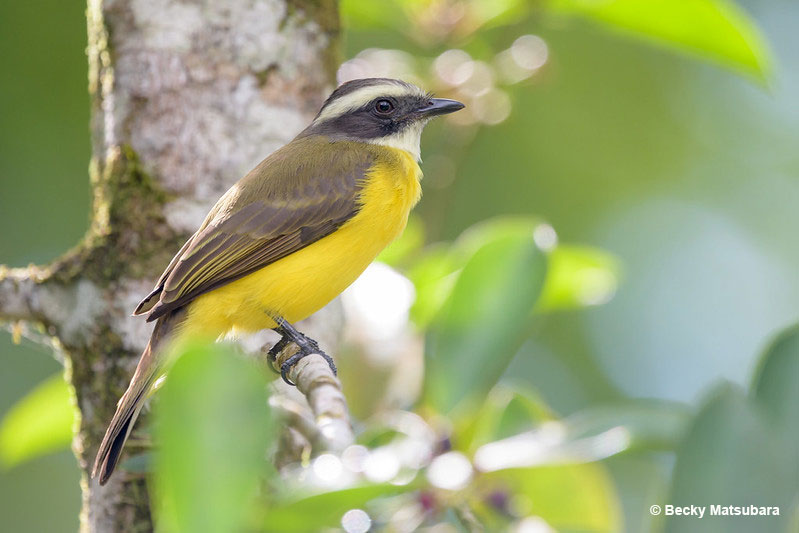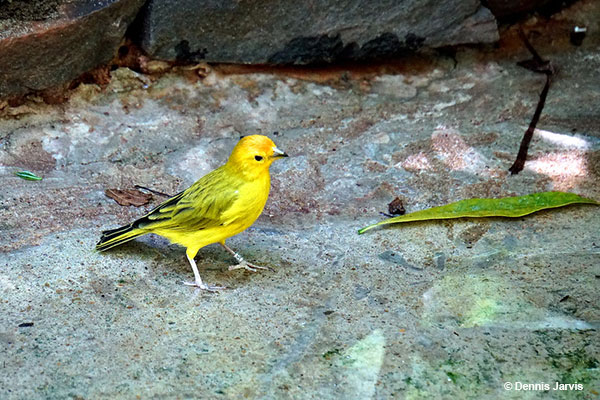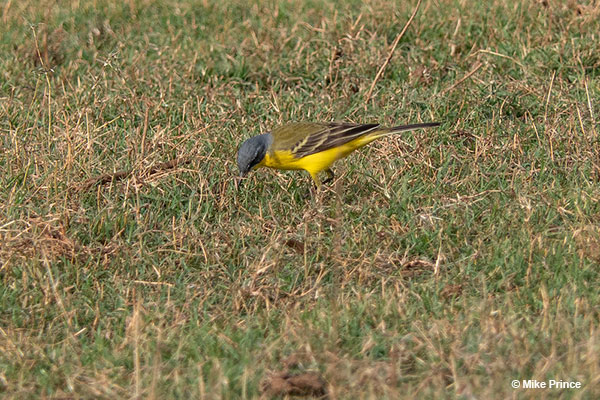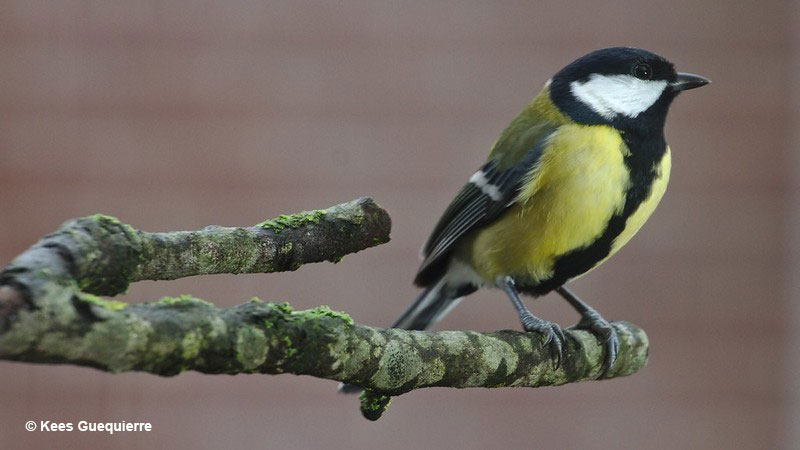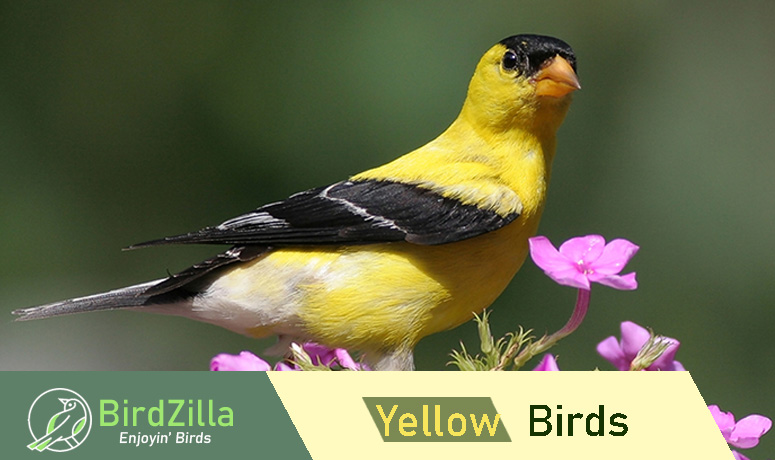
Yellow birds are common and easy to spot. There’s a reason for that – birds have incredible color vision, which is one of the reasons why the color of a bird’s plumage is so important.
Bright plumage is crucial for mating because bright plumage means a bird is strong and in good health. Additionally, the color of a bird’s plumage also benefits us because birders use colors and markings to identify birds.
We’ve compiled a list of the most common yellow birds, their descriptions, frequently asked questions, and more!
On this list, you’ll find birds that are completely yellow, partially yellow, or only have sections of yellow. We would like to mention that most of the yellow birds seen are females. Males of the same species may be red, orange, brown, etc.
See 26 of these bird species with beautiful yellow plumage below.
On this page
- #1 American Goldfinch
- #2 Yellow Warbler
- #3 Western Tanager
- #4 Yellow-Headed Blackbird
- #5 Common Yellowthroat
- #6 Evening Grosbeak
- #7 Yellow-Breasted Chat
- #8 Magnolia Warbler
- #9 Dickcissel
- #10 Female Summer Tanager
- #11 Bananaquit
- #12 Lesser Goldfinch
- #13 Orchard Oriole
- #14 Social Flycatcher
- #15 Couch’s Kingbird
- #16 Scott’s Oriole
- #17 Saffron Finch
- #18 Cassin’s Kingbird
- #19 Baltimore Oriole
- #20 Great Kiskadee
- #21 Eastern Yellow Wagtail
- #22 Prothonotary Warbler
- #23 Canada Warbler
- #24 Slate-Throated Redstart
- #25 Western Meadowlark
- #26 Great Tit
#1 American Goldfinch
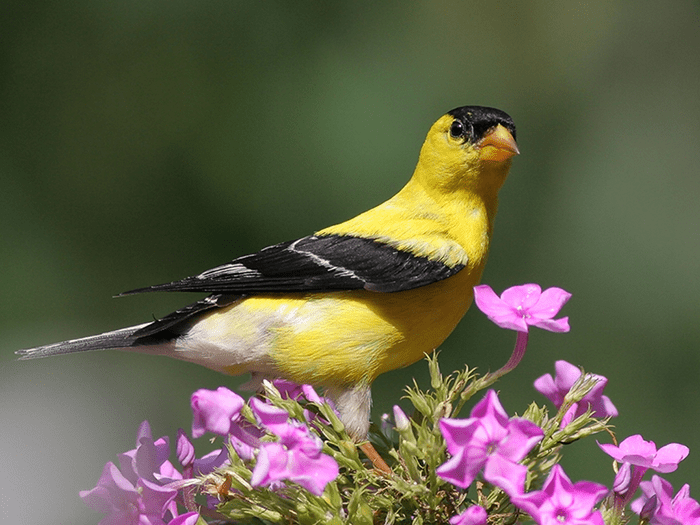
Male American Goldfinch
American Goldfinches are small birds. They have small heads, long wings, short tails, and conical, short bills.
Adult males in early summer and spring are bright yellow with black wings and black foreheads. In addition, they have white markings on the wings and white patches on the tail.
Adult females are olive above and a duller yellow below. Winter birds have blackish wings with two faint wing bars and are unstreaked brown.
These cheery creatures are some of the most commonly seen backyard birds in the United States.
#2 Yellow Warbler
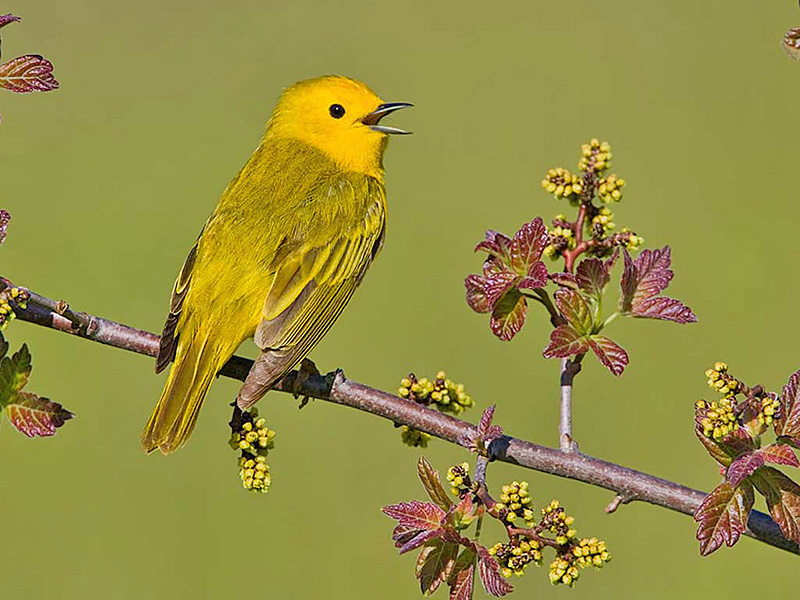
Yellow Warblers are small songbirds with yellow body. They have rounded heads and medium-length tails. The bill is relatively large, straight, and thin. Yellow Warblers are consistently yellow birds.
Males are a bright yellow and have reddish streaks on the underparts. Both males and females flash yellow patches on the tail. Their faces have no markings, which really emphasizes their large black eyes.
#3 Western Tanager
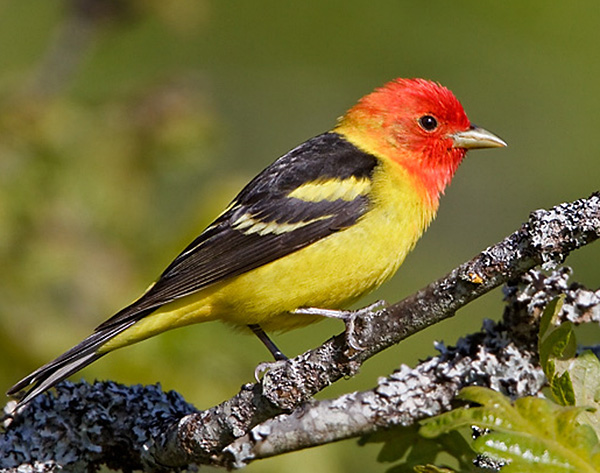
Western Tanager (Piranga ludoviciana) perched on a branch in Victoria, BC, Canada.
Western Tanagers are heavyset songbirds. However, they’re relatively small but noticeably larger than warblers. They have medium-length tails and thick-based bills.
Adult males are yellow, have black wings, and have bright orange-red heads. The wings have two vivid wing bars, one yellow and one white. The tail and back are black.
Adult females have red on the front of the face and yellow-green plumage on the body.
In North America, Western Tanagers can be spotted in the western sides of the USA and Canada.
#4 Yellow-Headed Blackbird
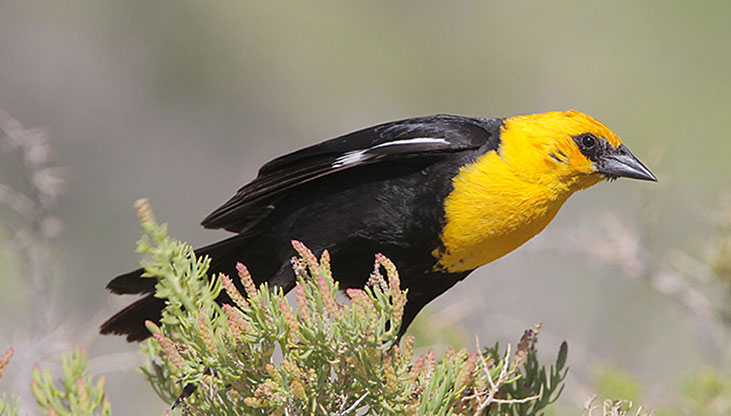
Yellow-headed Blackbirds are relatively large blackbirds. They have large heads, plump bodies, and conical, long bills.
Males are striking; they’re mostly black but have yellow chests and heads and white patches where the wings bend. Females and immatures have duller yellow heads and are brown instead of black.
These yellow-headed birds form flocks that can reach thousands in numbers.
#5 Common Yellowthroat
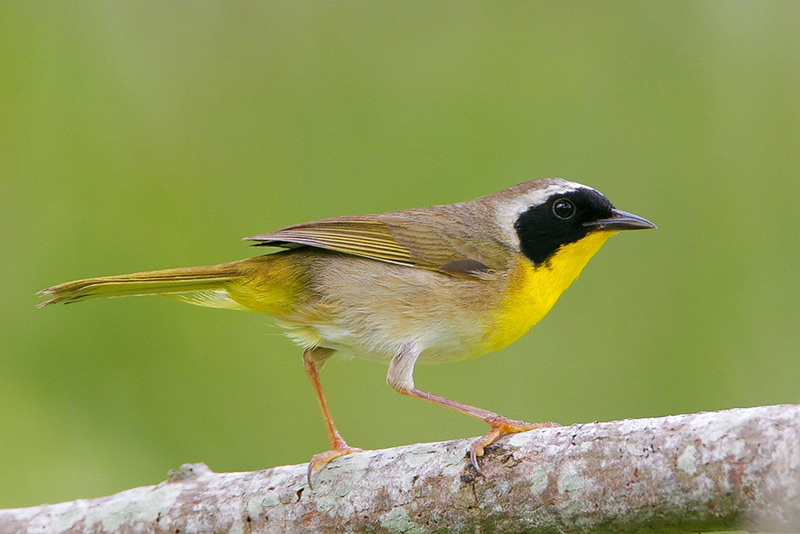
Photograph © Greg Lavaty.
Common Yellowthroats are small songbirds. They have medium-length, slightly rounded tails, and rounded heads. Adult males have olive underparts, are bright yellow below, and have a striking black face mask.
A thin white line runs between the mask from the neck and the head. Females are olive-brown and have yellow on the throat and under the tail. They do not have the black mask.
#6 Evening Grosbeak
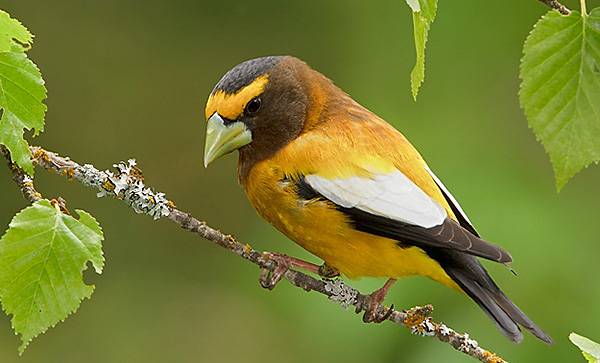
Photograph © Glenn Bartley.
Evening Grosbeaks are heavyset, large finches. They have short tails, thick, conical bills, thick necks, and full chests. Adult males are black and yellow birds and have noticeable white patches on the wings.
Their heads are dark, and a bright-yellow stripe goes over the eye. Females and immatures are mainly gray, have a greenish-yellow tint to the neck and flanks, and have white-and-black wings.
#7 Yellow-Breasted Chat
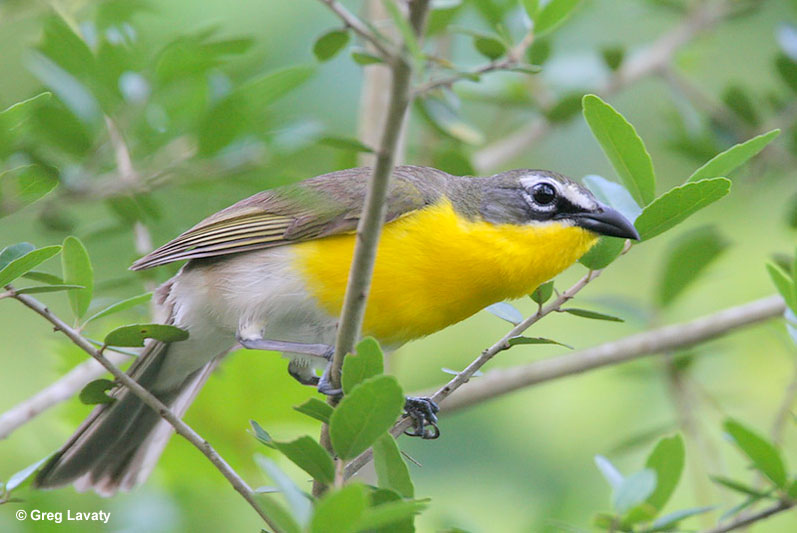
Yellow-Breasted Chats are relatively small songbirds but are bulkier and larger than warblers. These birds have large heads, thick bills, and long tails.
In addition, these birds have bold face markings, olive green above, and bright yellow breasts. Their faces are gray with white rings around the eyes connecting to the bill. The lower belly is white as well.
#8 Magnolia Warbler
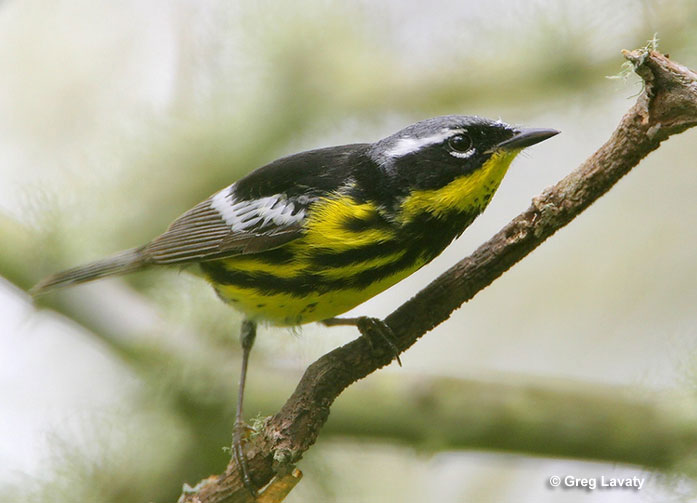
Magnolia Warblers are small songbirds. They have narrow, long tails and small bills. Adult males have distinctive black streaking and black masks.
Males have yellow throats, yellow bellies, gray and black plumage above, and wide white wing patches. Females have gray heads, white eyerings, 2 white wing bars, and a faint gray band on the neck.
The tails are white at the base and black at the tip.
Magnolia Warblers (and other yellow warblers, such as Nashville Warblers, Pine Warblers, and sometimes even Yellow-rumped Warblers) can be found in a variety of habitats – ranging from parks to edges of forests and shrubs.
#9 Dickcissel
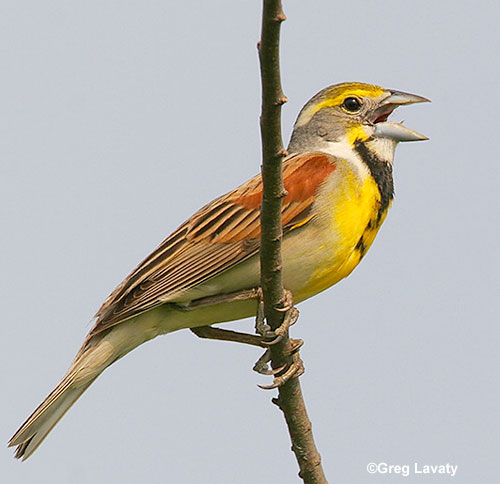
Dickcissels are compact, sparrowlike birds who are known for their bright yellow coloring. They have short tails, thick, large bills, and full chests. Adult males have yellow faces and chests, grayish heads, and a bold black V on the neck.
The shoulders are reddish-brown, and the back is gray and brown. Females look similar but lack the black V on the throat and have a more muted pattern.
This songbird feeds on insects and seeds.
#10 Female Summer Tanager
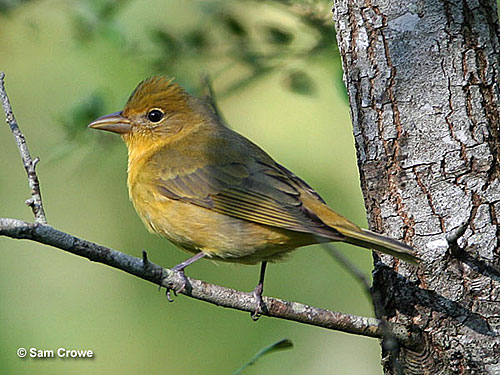
Summer Tanager
Summer Tanagers are chunky, medium-sized songbirds. They have large heads and big bodies. Their bills are blunt, large, and thick. Although females and immature males are bright yellow-green, they’re yellower on the underparts and head and slightly greener on the wings and back. Their bills are pale.
Summer Tanagers make a cup-shaped nest. There are usually 3-4 eggs in the nest. They prefer open woodlands and second-growth forests.
#11 Bananaquit
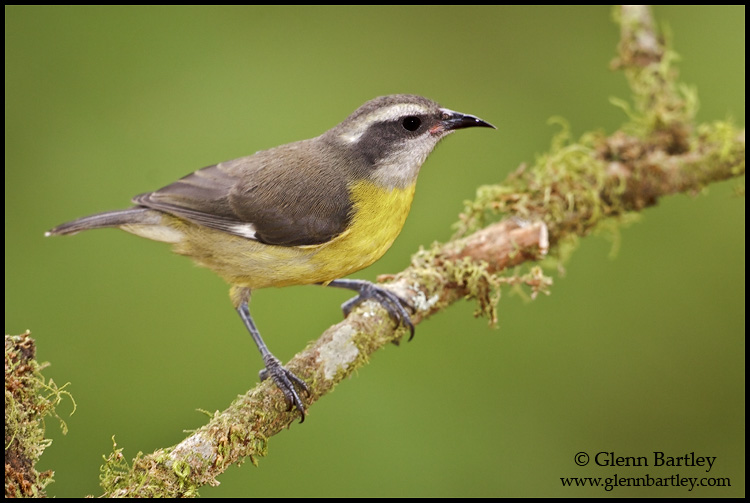
Bananaquit (Coerba flaveola) perched on a branch at Buenaventura Lodge in southwest Ecuador.
Bananaquits are small and very active warbler-like birds. These birds have variable plumage across their range. Most of the Bananaquit population have bold white eyebrows and yellow underparts.
Throat color also varies from white, pale gray, and sooty gray. Some birds in their range are entirely black.
#12 Lesser Goldfinch
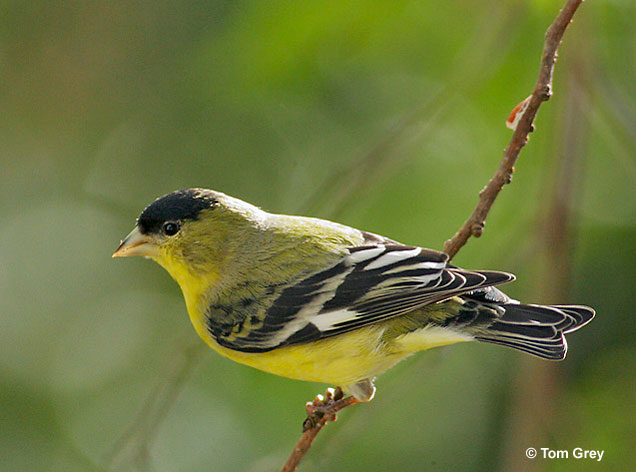
Lesser Goldfinches are tiny songbirds with bright yellow belly areas. They have short, notched tails and long, pointed wings. Males have white patches on the wings, glossy black caps, and bright yellow below.
Their backs can be a dull green or glossy black. Their tails have white corners and are mostly black. Females have dull yellow underparts, olive backs, and black wings.
Lesser Goldfinches often come to bird feeders and can be found in a variety of habitats, such as parks, open woodlands, grasslands, thickets, and other similar areas.
At backyard feeders, they enjoy snacking on different kinds of seeds.
#13 Orchard Oriole
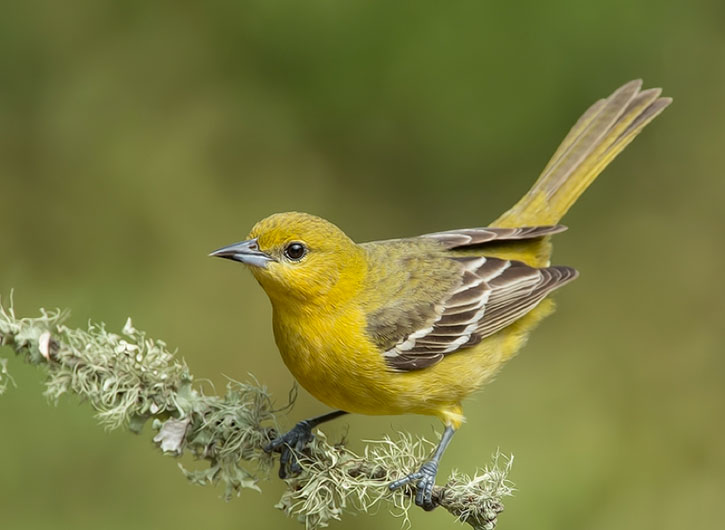
Photograph © Alan Wilson.
Orchard Orioles are slender songbirds and are larger than warblers. They have rounded heads, straight, sharply pointed bills, and medium-length tails.
Female Orchard Orioles are greenish-yellow overall and have two white wing bars. Immature male Orchard Orioles look like females but have black around the throat and bill.
#14 Social Flycatcher
Social Flycatchers are medium-sized flycatchers. They have dark gray on their heads, a bold white eye stripe, and a concealed brown stripe on their crowns.
Social Flycatchers also have olive brown on their upper parts, and their wings and tails are a darker brown. In addition, the throat is white, and the underparts are yellow.
#15 Couch’s Kingbird
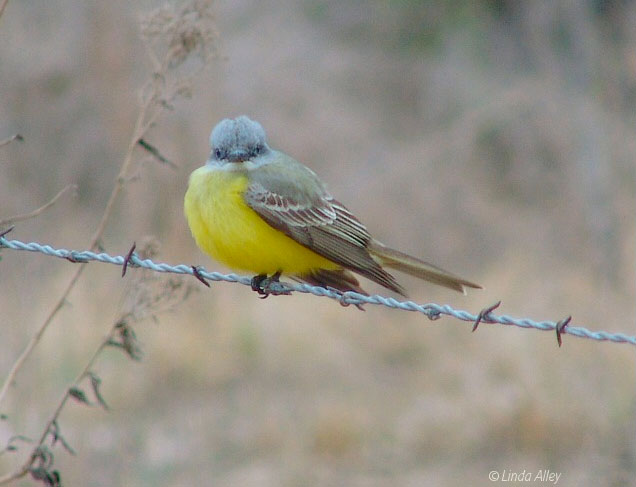
Couch’s Kingbirds are bulky, large flycatchers. They have long tails, long wings, and straight, heavy bills.
Male and Female Couch’s Kingbirds look almost identical. These birds have a yellow breast, pale gray heads, dark bills, dark legs, whitish throats, and gray-brown to somewhat greenish upper parts.
#16 Scott’s Oriole
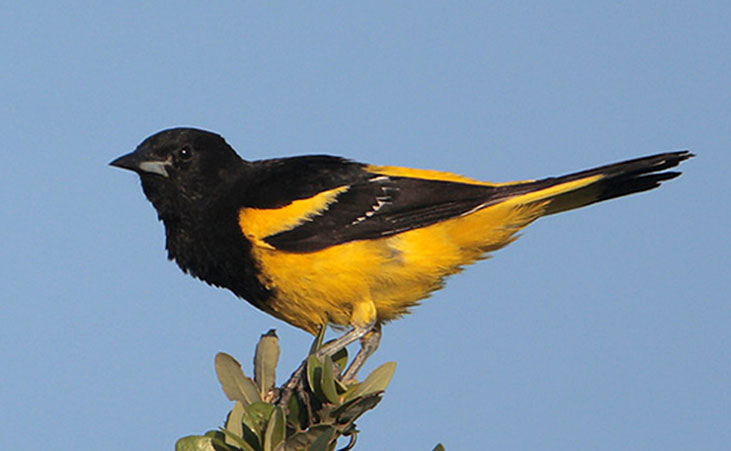
Scott’s Orioles are medium-sized birds. They have sturdy bodies, long tails, straight, long bills, and solid feet and legs.
Adult male Scott’s Orioles are black above, bright yellow below, and have black throats and chests. They also have yellow shoulders, black and yellow tails, and white wing bars.
Adult female Scott’s Orioles are olive-green above and a muted yellow below. They also have some stippling on the head and faint wing bars.
Like other orioles, Scott’s Orioles like nectar, so they can be spotted at your feeders.
#17 Saffron Finch
Saffron Finches are medium-sized finches. Male Saffron Finches are mostly bright yellow and have vivid orange on their foreheads.
There’s less brownish-olive color on their backs and wings like many yellow finches do. There are some regional differences. Southern populations tend to be duller and have browner above.
Female Saffron Finches are duller than males, and southern populations are streakier and browner.
#18 Cassin’s Kingbird
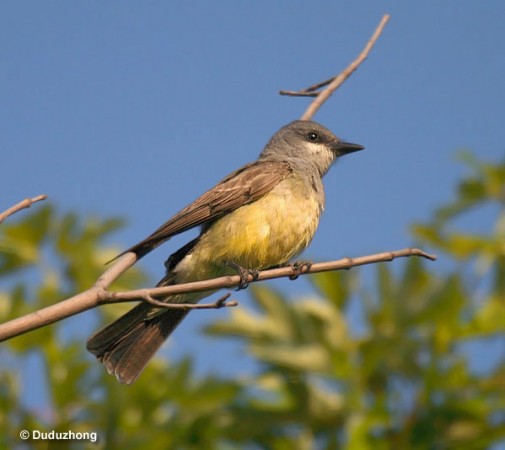
Cassin’s Kingbirds are compact but powerful flycatchers. They have smaller heads, straight, heavy bills, and somewhat long tails and wings. Cassin’s Kingbirds have gray heads, yellow bellies, and white throats. The tails and wings are brown.
Their tails’ outer feathers are not white. However, you can see that the tip is pale.
#19 Baltimore Oriole
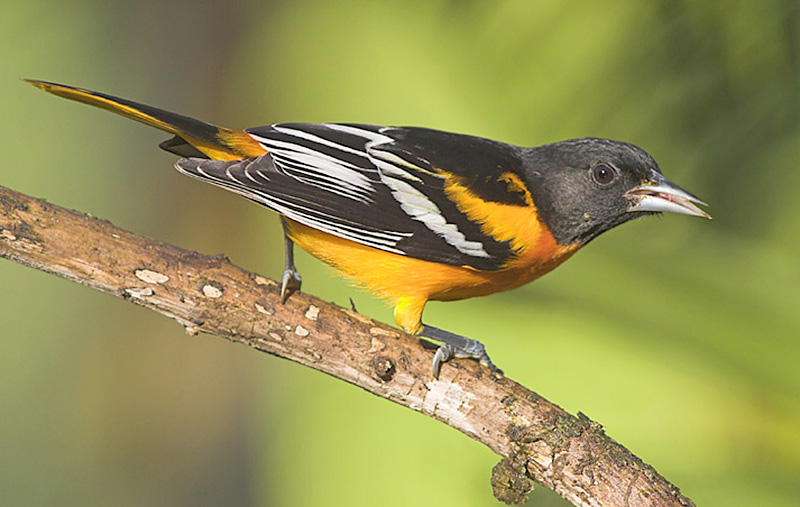
Baltimore Orioles are smaller than American Robins. They’re medium-sized birds with sturdy bodies, long legs, and thick necks. Their bills are distinct due to their thick base, length, and point.
Females and immature males are grayish on their heads, yellowy-orange on the breast, and have two white wing bars.
#20 Great Kiskadee
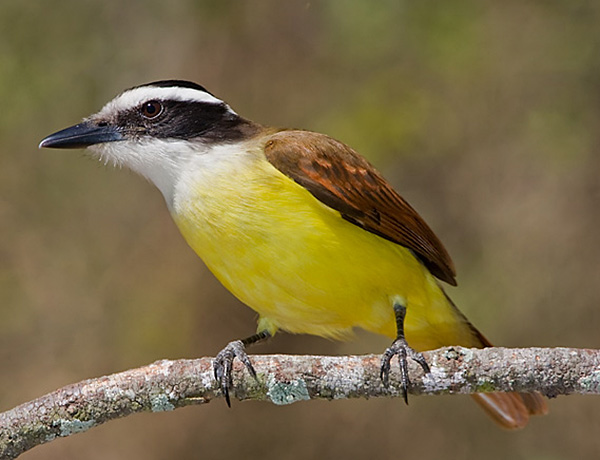
Photograph © Glenn Bartley.
Great Kiskadees are blocky, large flycatchers. They have thick necks, large heads, and straight bills. Their wings are rounded and wide, and their tails are square-tipped and medium-length.
Great Kiskadees are striking with their reddish-brown, white, black, and yellow mix. Their heads are black; they have bold white eyebrows, white throats, and their underparts are yellow.
Their tails and wings are reddish-brown, which is very noticeable in flight.
#21 Eastern Yellow Wagtail
Eastern Yellow Wagtails are long-tailed, slender birds. Their plumage can vary, but mainly their underparts are bright yellow, their backs are grayish-olive, and they have pale throats.
Their tails are black and have white on their outer feathers. Young Eastern Yellow Wagtails lack yellow and have a distinctive head pattern.
#22 Prothonotary Warbler
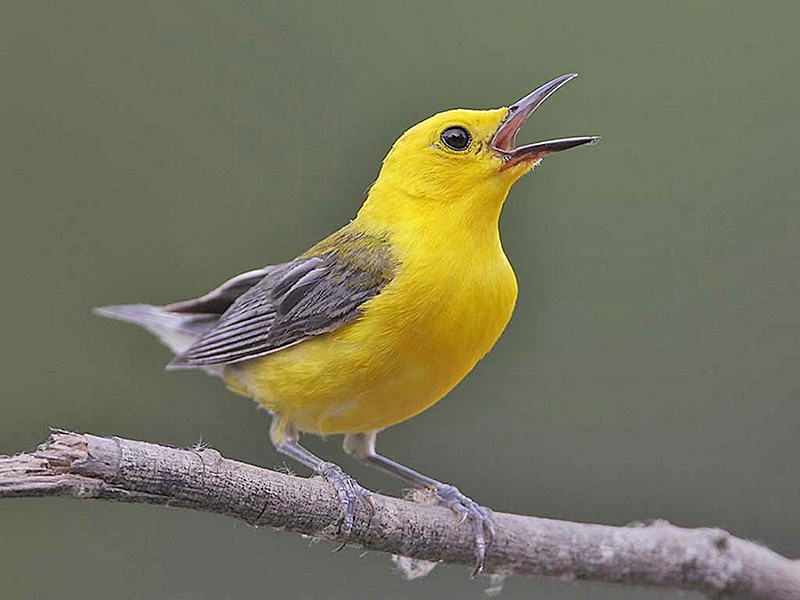
Photograph © Greg Lavaty.
Prothonotary Warbler is a small yellow bird with dark gray wings and tail. They are easily recognized by their bright yellow head. Although these warblers look stocky, they are only around 5 inches long.
Females and males look similar, but male Prothonotary Warblers tend to have brighter plumage.
#23 Canada Warbler
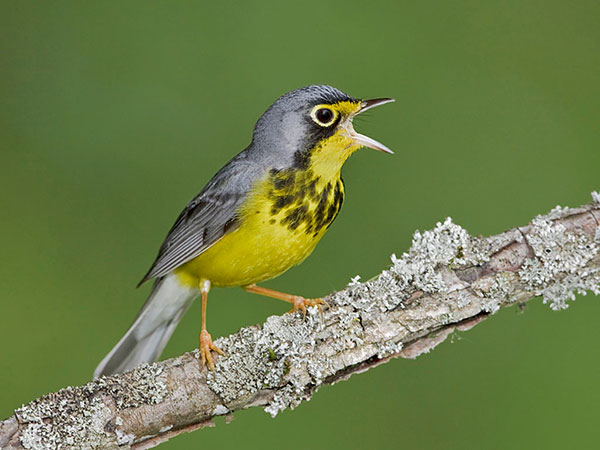
Canada Warblers are well-proportioned and small birds. Compared to other warblers, they have fuller chests, longer tails, and straight, sharp bills.
These birds are bright yellow below, blue-gray above, and have apparent white eyerings. The most noticeable feature of these birds is the the black “necklace” that runs across their chests.
#24 Slate-Throated Redstart
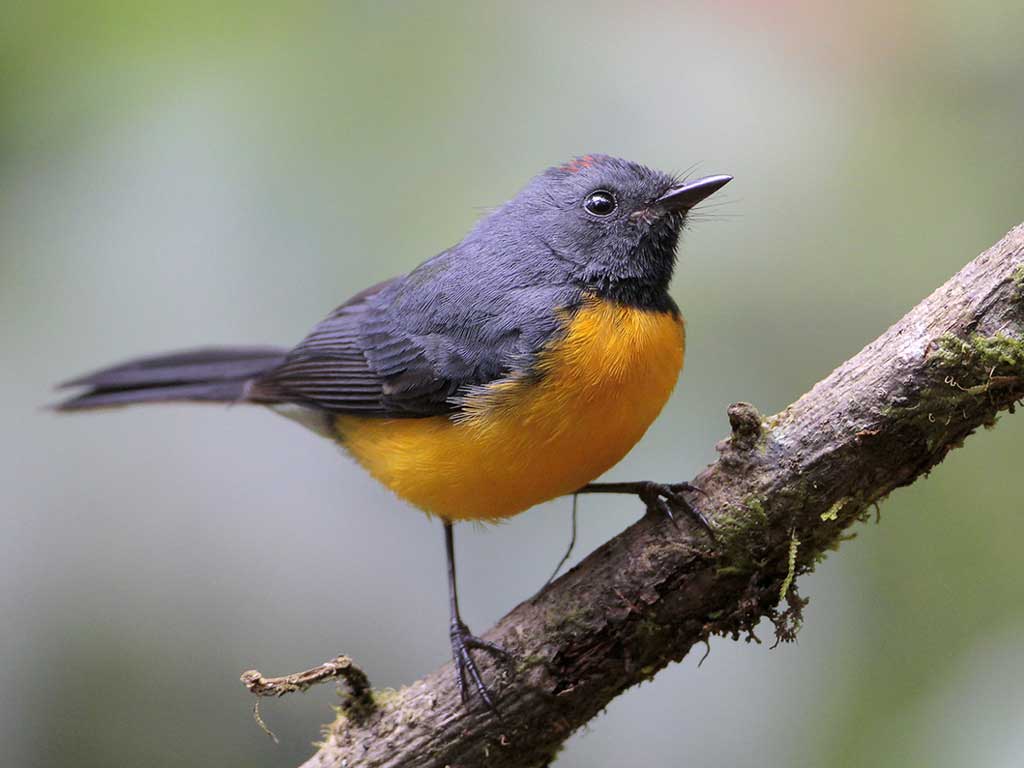
Male and female Slate-throated Redstarts look almost identical, and their plumage changes depending on their region. Their upper parts and heads are slaty gray.
They have black faces and rusty orange caps. In Mexico, their bellies are red; in northern Central America, they’re orangey-red; and in Costa Rica and South America, they’re yellow.
The tails are white-tipped and usually fanned side-to-side.
#25 Western Meadowlark
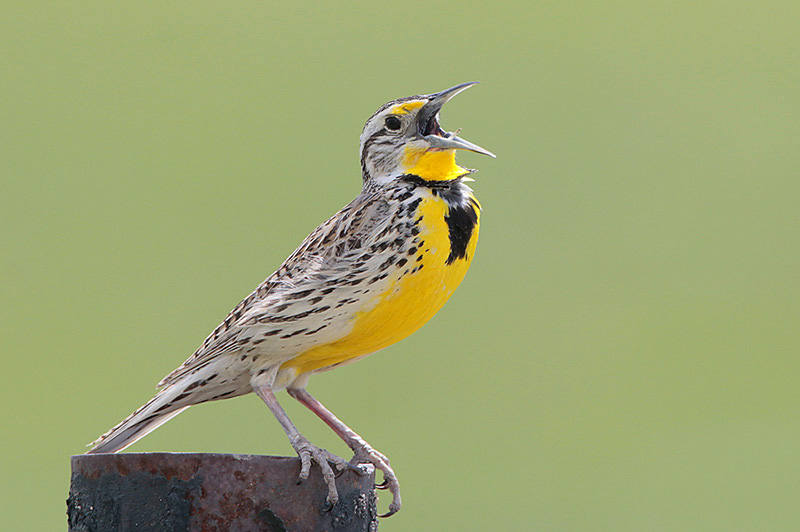
Western Meadowlarks are about the size of a robin but have shorter tails and are chunkier.
They have slender bills, rounded shoulders, flat heads, and slender, long bills. Western Meadowlarks have elaborately patterned buff, black, brown upperparts and yellow underparts.
A black “V” crosses the breast, contrasting light buff and dark brown stripes can be seen on the head, and the outer tail feathers have a flash of white.
#26 Great Tit
Great Tits have distinct plumage; they have white cheeks surrounded by a black bib and cap. Male Great Tits have a broad black stripe down the belly that females lack.
Juveniles have dull yellow on their faces and fainter plumage overall. Their underparts are bright yellow throughout most of their range, but in Central Asia, they have white bellies.
Did we miss something? Let us know in the comments!


